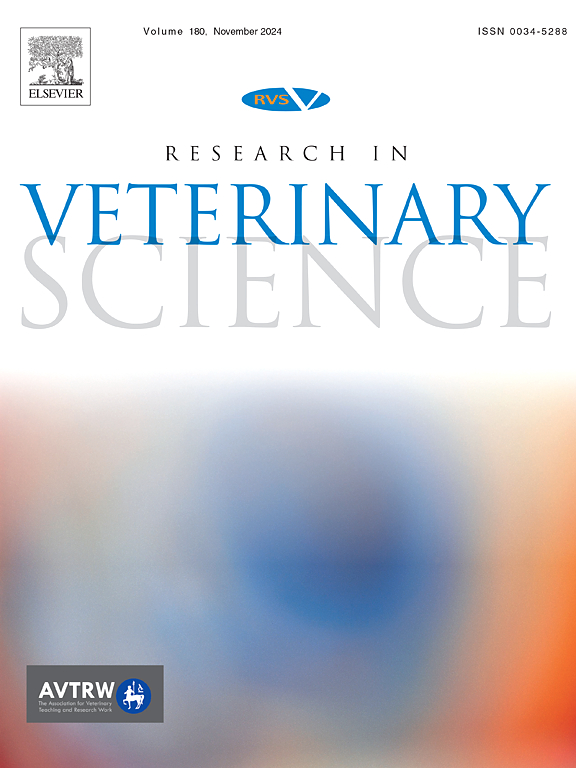一项随机、前瞻性、盲法临床试验:对接受卵巢切除术的猫进行腹腔内左布比卡因单独使用或与右美托咪定联合使用的术中和术后镇痛效果比较。
IF 1.8
3区 农林科学
Q1 VETERINARY SCIENCES
引用次数: 0
摘要
本研究旨在比较左旋布比卡因与右旋美托咪定对接受卵巢切除术的猫的镇痛和心肺作用。在这项前瞻性、随机和盲法临床试验中,共招募了 24 只健康猫咪。动物分别接受生理盐水(S 组;2 mL NaCl)、单独左旋布比卡因(Lev;0.35 mg/kg)或左旋布比卡因联合右美托咪定(LevDex 组;0.004 mg/kg)治疗,术中将左旋布比卡因浸润到不同切口部位的皮下组织,包括左右卵巢蒂和子宫体尾部。术中镇痛采用累积疼痛量表进行评估,术后镇痛则在不同的时间点进行评估:术前(Tb)、术后 0 小时(T0)、1 小时(T1h)、2 小时(T2h)、4 小时(T4h)、8 小时(T8h)、12 小时(T12h)和 24 小时(T24h),采用 UNESP-Botucatu 多维综合疼痛量表(MCPS)进行评估。与 S 组和 Lev 组相比,左旋地塞米松组的心率、呼吸频率和平均动脉压明显下降(p 1h 和 T2h),S 组的 MCPS 评分明显高于 Lev 组和左旋地塞米松组(p = 0.029)。然而,在 T8h 时,S 组和 LevDex 组之间没有发现明显差异(p = 0.741)。虽然在左旋布比卡因中加入右美托咪定可能会稍微延长术后镇痛时间,但就对手术刺激的反应而言,这种组合与单独使用左旋布比卡因相比并没有明显的额外益处。本文章由计算机程序翻译,如有差异,请以英文原文为准。
Comparison of intra and postoperative analgesia efficacy of intraperitoneal levobupivacaine alone or in combination with dexmedetomidine in cats undergoing ovariohysterectomy; a randomized, prospective, blinded, clinical trial
This study aimed to compare the analgesic and cardiopulmonary effects of levobupivacaine with or without dexmedetomidine, in cats undergoing ovariohysterectomy. In this prospective, randomized, and blinded clinical trial, 24 healthy cats were recruited. Animals received either saline (S group; 2 mL NaCl), levobupivacaine alone (Lev; 0.35 mg/kg), or levobupivacaine with dexmedetomidine (LevDex group; 0.004 mg/kg), which was infiltrated intraoperatively into the subcutaneous tissue at various incision sites, including the right and left ovarian pedicles and the caudal aspect of the uterine body. Intraoperative analgesia was evaluated using a cumulative pain scale, while postoperative analgesia was assessed at various time points: before surgery (Tb), and at 0 (T0), 1 (T1h), 2 (T2h), 4 (T4h), 8 (T8h), 12 (T12h), and 24 (T24h) hours after the procedure, using the UNESP-Botucatu multidimensional composite pain scale (MCPS). Significant decreases in heart rate, respiratory rate, and mean arterial pressure were observed in LevDex group as compared to S and Lev groups (p < 0.05). The S group required significantly more rescue morphine doses than the LevDex group (p = 0.029), but the difference was not significant when compared to the Lev group (p = 0.123). At T1h and T2h, the S group had significantly higher MCPS scores than both the Lev and LevDex groups (p = 0.029). However, at T8h, no significant difference was found between the S and LevDex groups (p = 0.741). While adding dexmedetomidine to levobupivacaine may slightly prolong postoperative analgesia, this combination does not provide significant additional benefit over levobupivacaine alone in terms of response to surgical stimulation.
求助全文
通过发布文献求助,成功后即可免费获取论文全文。
去求助
来源期刊

Research in veterinary science
农林科学-兽医学
CiteScore
4.40
自引率
4.20%
发文量
312
审稿时长
75 days
期刊介绍:
Research in Veterinary Science is an International multi-disciplinary journal publishing original articles, reviews and short communications of a high scientific and ethical standard in all aspects of veterinary and biomedical research.
The primary aim of the journal is to inform veterinary and biomedical scientists of significant advances in veterinary and related research through prompt publication and dissemination. Secondly, the journal aims to provide a general multi-disciplinary forum for discussion and debate of news and issues concerning veterinary science. Thirdly, to promote the dissemination of knowledge to a broader range of professions, globally.
High quality papers on all species of animals are considered, particularly those considered to be of high scientific importance and originality, and with interdisciplinary interest. The journal encourages papers providing results that have clear implications for understanding disease pathogenesis and for the development of control measures or treatments, as well as those dealing with a comparative biomedical approach, which represents a substantial improvement to animal and human health.
Studies without a robust scientific hypothesis or that are preliminary, or of weak originality, as well as negative results, are not appropriate for the journal. Furthermore, observational approaches, case studies or field reports lacking an advancement in general knowledge do not fall within the scope of the journal.
 求助内容:
求助内容: 应助结果提醒方式:
应助结果提醒方式:


